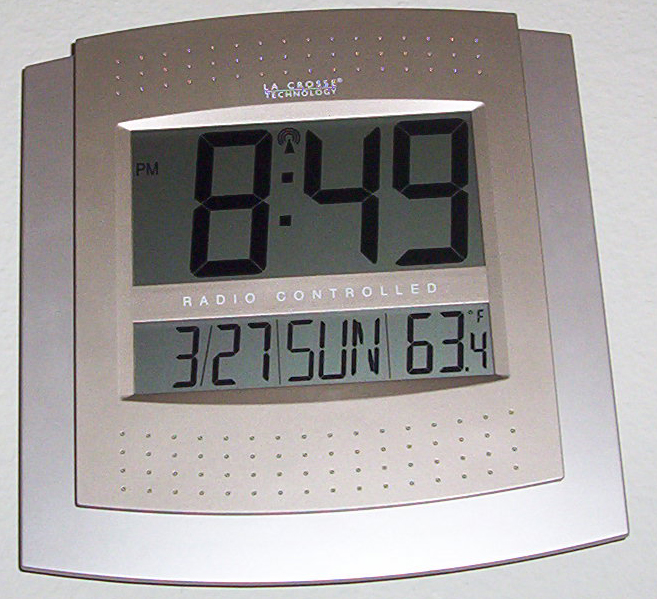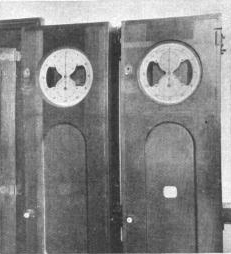|
DCF77
DCF77 is a German longwave time signal and standard-frequency radio station. It started service as a standard-frequency station on 1 January 1959. In June 1973 date and time information was added. Its primary and backup transmitter are located at in Mainflingen, about 25 km south-east of Frankfurt am Main, Germany. The transmitter generates a nominal power of 50 kW, of which about 30 to 35 kW can be radiated via a T-antenna. DCF77 is controlled by the ''Physikalisch-Technische Bundesanstalt'' (PTB), Germany's national physics laboratory and transmits in continuous operation (24 hours). It is operated by ''Media Broadcast GmbH'' (previously a subsidiary of ''Deutsche Telekom AG''), on behalf of the PTB. With Media Broadcast GmbH, a temporal transmission availability of at least 99.7% per year or under 26.28 hours of annual downtime has been agreed upon. Most service interruptions are short-term disconnections of under two minutes. Longer lasting transmission servi ... [...More Info...] [...Related Items...] OR: [Wikipedia] [Google] [Baidu] |
Radio Clock
A radio clock or radio-controlled clock (RCC), and often (incorrectly) referred to as an atomic clock is a type of quartz clock or watch that is automatically synchronized to a time code transmitted by a radio transmitter connected to a time standard such as an atomic clock. Such a clock may be synchronized to the time sent by a single transmitter, such as many national or regional time transmitters, or may use the multiple transmitters used by satellite navigation systems such as Global Positioning System. Such systems may be used to automatically set clocks or for any purpose where accurate time is needed. RC clocks may include any feature available for a clock, such as alarm function, display of ambient temperature and humidity, broadcast radio reception, etc. One common style of radio-controlled clock uses time signals transmitted by dedicated terrestrial longwave radio transmitters, which emit a time code that can be demodulated and displayed by the radio controlled clock. ... [...More Info...] [...Related Items...] OR: [Wikipedia] [Google] [Baidu] |
Mainflingen
Mainflingen is a village and part (''Ortsteil'') of the municipality Mainhausen, in the district of Offenbach in Hesse with about 4000 inhabitants. It is known for its time signal transmitter, DCF77, which controls almost all radio clocks in Western Europe. Geography Location Mainflingen is part of the municipality Mainhausen, which lies in the Offenbach district, located in the southernmost part of the state Hesse right on the border with Bavaria. It lies near the river Main. Constituent communities Mainflingen is one of the two constituent communities of Mainhausen, the other one is Zellhausen. History Mainflingen was first mentioned in a document from the year 775. In this and other documents from 793, 796 and 799 it is confirmed that citizens of the municipality Manolfingen bequeathed fields and meadows to the monastery Lorsch. Researchers believe that the name is not derived from the river Main, but from a man named Manolf and his ancestors. A document confirms that Wit ... [...More Info...] [...Related Items...] OR: [Wikipedia] [Google] [Baidu] |
Physikalisch-Technische Bundesanstalt
The Physikalisch-Technische Bundesanstalt (PTB) is the national metrology institute of the Federal Republic of Germany, with scientific and technical service tasks. It is a higher federal authority and a public-law institution directly under federal government control, without legal capacity, under the auspices of the Federal Ministry for Economic Affairs and Energy. Tasks Together with NIST in the USA and the NPL in Great Britain, PTB ranks among the leading metrology institutes in the world. As the National Metrology Institute of Germany, PTB is Germany's highest and only authority in terms of correct and reliable measurements. The Units and Time Act Bundesgesetzblatt (Federal Law Gazette), volume 2008, part I, No. 28, p. 1185 ff., 11 July 2008] assigns all tasks which are related with the realization and dissemination of the units to PTB. All legally relevant aspects regarding the units as well as PTB’s responsibilities have been combined in this Act. Previously, a ... [...More Info...] [...Related Items...] OR: [Wikipedia] [Google] [Baidu] |
Braunschweig
Braunschweig () or Brunswick ( , from Low German ''Brunswiek'' , Braunschweig dialect: ''Bronswiek'') is a city in Lower Saxony, Germany, north of the Harz Mountains at the farthest navigable point of the river Oker, which connects it to the North Sea via the rivers Aller and Weser. In 2016, it had a population of 250,704. A powerful and influential centre of commerce in medieval Germany, Brunswick was a member of the Hanseatic League from the 13th until the 17th century. It was the capital city of three successive states: the Principality of Brunswick-Wolfenbüttel (1269–1432, 1754–1807, and 1813–1814), the Duchy of Brunswick (1814–1918), and the Free State of Brunswick (1918–1946). Today, Brunswick is the second-largest city in Lower Saxony and a major centre of scientific research and development. History Foundation and early history The date and circumstances of the town's foundation are unknown. Tradition maintains that Brunswick was created through the merge ... [...More Info...] [...Related Items...] OR: [Wikipedia] [Google] [Baidu] |
Low Frequency
Low frequency (LF) is the ITU designation for radio frequencies (RF) in the range of 30–300 kHz. Since its wavelengths range from 10–1 km, respectively, it is also known as the kilometre band or kilometre wave. LF radio waves exhibit low signal attenuation, making them suitable for long-distance communications. In Europe and areas of Northern Africa and Asia, part of the LF spectrum is used for AM broadcasting as the "longwave" band. In the western hemisphere, its main use is for aircraft beacon, navigation (LORAN), information, and weather systems. A number of time signal broadcasts also use this band. Propagation Because of their long wavelength, low frequency radio waves can diffract over obstacles like mountain ranges and travel beyond the horizon, following the contour of the Earth. This mode of propagation, called ''ground wave'', is the main mode in the LF band. Ground waves must be vertically polarized (the electric field is vertical while the magnet ... [...More Info...] [...Related Items...] OR: [Wikipedia] [Google] [Baidu] |
Mainflingen Longwave Transmitter
Mainflingen longwave transmitter is a large facility for commercial longwave transmissions at Mainflingen, Hesse, Germany, which was built in 1956. It uses several T- and triangle antennas, which are mounted on guyed masts of lattice steel, insulated against ground. The used masts have heights between 150 metres and 200 metres. Southeast of the main antenna area, which is completely fenced in, but still north of the motorway A3 there is a further T-antenna, which is mounted on two guyed masts of lattice steel insulated against ground. Further there is a tower built of prefabricated concrete segments for mobile phone services close to the transmitter building. All transmitters using the facility have a call sign starting with DCF. The best known of them is DCF77 longwave time signal and standard-frequency radio station. In earlier times the facility was also used for longwave broadcasting, especially as backup transmitter for Sender Donebach. See also * Mainflingen mediumwave tran ... [...More Info...] [...Related Items...] OR: [Wikipedia] [Google] [Baidu] |
Longwave
In radio, longwave, long wave or long-wave, and commonly abbreviated LW, refers to parts of the radio spectrum with wavelengths longer than what was originally called the medium-wave broadcasting band. The term is historic, dating from the early 20th century, when the radio spectrum was considered to consist of longwave (LW), medium-wave (MW), and short-wave (SW) radio bands. Most modern radio systems and devices use wavelengths which would then have been considered 'ultra-short'. In contemporary usage, the term ''longwave'' is not defined precisely, and its intended meaning varies. It may be used for radio wavelengths longer than 1,000 m i.e. frequencies up to 300 kilohertz (kHz), including the International Telecommunication Union's (ITU's) low frequency (LF, 30–300 kHz) and very low frequency (VLF, 3–30 kHz) bands. Sometimes the upper limit is taken to be higher than 300 kHz, but not above the start of the medium wave broadcast band at 520&nb ... [...More Info...] [...Related Items...] OR: [Wikipedia] [Google] [Baidu] |
Time Signal
A time signal is a visible, audible, mechanical, or electronic signal used as a reference to determine the time of day. Church bells or voices announcing hours of prayer gave way to automatically operated chimes on public clocks; however, audible signals (even signal guns) have limited range. Busy seaports used a visual signal, the dropping of a ball, to allow mariners to check the chronometers used for navigation. The advent of electrical telegraphs allowed widespread and precise distribution of time signals from central observatories. Railways were among the first customers for time signals, which allowed synchronization of their operations over wide geographic areas. Dedicated radio time signal stations transmit a signal that allows automatic synchronization of clocks, and commercial broadcasters still include time signals in their programming. Today, global navigation satellite systems (GNSS) radio signals are used to precisely distribute time signals over much of the world ... [...More Info...] [...Related Items...] OR: [Wikipedia] [Google] [Baidu] |
Watch
A watch is a portable timepiece intended to be carried or worn by a person. It is designed to keep a consistent movement despite the motions caused by the person's activities. A wristwatch is designed to be worn around the wrist, attached by a watch strap or other type of bracelet, including metal bands, leather straps or any other kind of bracelet. A pocket watch is designed for a person to carry in a pocket, often attached to a chain. Watches were developed in the 17th century from spring-powered clocks, which appeared as early as the 14th century. During most of its history the watch was a mechanical device, driven by clockwork, powered by winding a mainspring, and keeping time with an oscillating balance wheel. These are called ''mechanical watches''. In the 1960s the electronic ''quartz watch'' was invented, which was powered by a battery and kept time with a vibrating quartz crystal. By the 1980s the quartz watch had taken over most of the market from the mechani ... [...More Info...] [...Related Items...] OR: [Wikipedia] [Google] [Baidu] |
Time In Germany
The time zone in Germany is Central European Time (, ''MEZ''; UTC+01:00) and Central European Summer Time (, ''MESZ''; UTC+02:00). Daylight saving time is observed from the last Sunday in March (02:00 CET) to the last Sunday in October (03:00 CEST). The doubled hour during the switch back to standard time is named 2A (02:00 to 03:00 CEST) and 2B (02:00 to 03:00 CET). IANA time zone database The IANA time zone database contains two zones for Germany, "Europe/Berlin" and "Europe/Busingen", although in 1945, the Trizone did not follow Berlin's switch to midsummer time. Germany had been politically divided into East Germany and West Germany at and after the start of the unix epoch, which is the date from which the tz database wants to record correct information. The database aims to include at least one zone for every ISO 3166-1 alpha-2 country code. This list was first issued in 1997, after the reunification of Germany in 1990. Hence only the unified Germany is listed. The zone ... [...More Info...] [...Related Items...] OR: [Wikipedia] [Google] [Baidu] |





